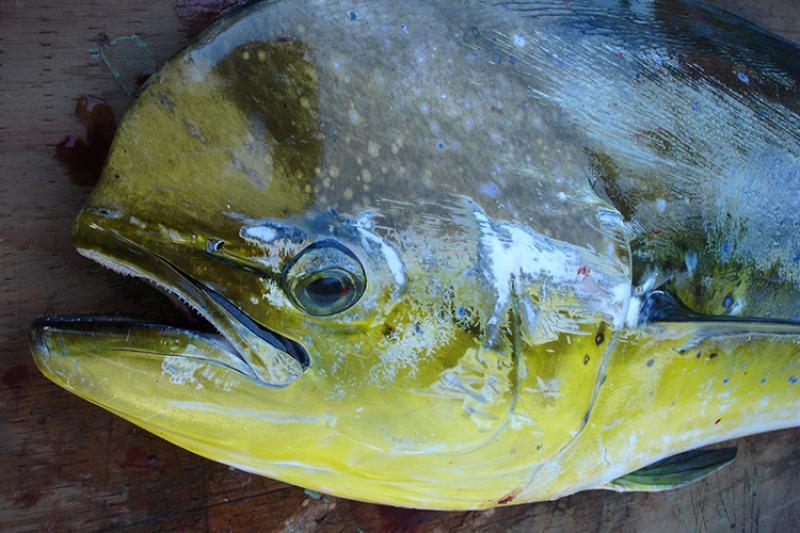
NOAA enlists Hawaii fishermen for Mahimahi diet study
by NOAA Fisheries 25 Sep 2022 20:41 UTC

Mahimahi are fun to catch and quite acrobatic. Plus, they are great to eat! © NOAA Fisheries
To fishermen in Hawaii, Pacific mahimahi stomachs hold no particular value and are typically discarded. To NOAA scientists researching mahimahi diet, however, each stomach tells a unique story about where and what an individual fish ate.
Mahimahi is a federally managed fish popular among recreational and commercial fishermen in Hawaii. And it's a fish we still have much to learn about—especially when it comes to their diet and role in marine ecosystems. That's where local fishermen come in!
NOAA Fisheries scientists and fishery managers are enlisting the help of local fishermen to collect mahimahi stomachs for research.
The stomach contents will help NOAA scientists better understand what these predatory fish are eating. They'll also reveal how much of the fish's diet comes from pelagic (open-ocean) life stages of coral reef animals.
"Collaborating with the fishing community is an important component of this work," said Keith Kamikawa, fishery management specialist, NOAA Fisheries Pacific Islands Regional Office. "We're conducting science while getting Hawaii fishermen and anglers involved."
Essential habitat for Mahimahi
Under the Magnuson-Stevens Act, NOAA Fisheries must prevent overfishing of federally managed fish and rebuild overfished stocks. Part of this work involves protecting their essential fish habitat—the habitat fish require to thrive throughout every life stage.
With this in mind, one has to wonder: why does it matter what mahimahi are eating? And how do inshore coral reef habitats impact the open-ocean-dwelling mahimahi?
"While coral reef fish live their adult lives near shore, when they mature and spawn, their larvae drift out to sea and develop in the open ocean," Kamikawa explained. "There they grow from tiny plankton to pelagic juveniles just a couple of inches long."
These juvenile reef fish may become prey of mahimahi (and other pelagic predators) while on their way back to the reef to grow into adults.
If these reef-associated species are an important part of mahimahi diet, protecting coral reef habitats where they mature and spawn could play a significant role in maintaining populations of mahimahi around the islands. As mahimahi supports many local, small commercial, and recreational fishermen in Hawaii, it is important to understand their life history—by diving into their stomachs.
Benefits for fishermen and science
NOAA scientists studying mahimahi diet rely on stomach samples donated from recreational, subsistence, and charter fishermen. The number of stomachs obtained by collaborating local fishermen is significantly larger than what NOAA researchers could collect alone.
Fishermen are going to mahimahi areas within the main Hawaiian Islands more consistently than a fleet of NOAA small boats could. They can provide scientists with stomach samples year-round.
To encourage participation, NOAA is piloting a "punch card" program to obtain stomachs from recently caught mahimahi. Along with the fish stomachs, fishermen must share the catch location, type of bait used, and size of the fish, among other catch-related information.
Fishermen will receive one point for every stomach donated with a full set of data. For every 10 points, they will get a $50 gift card to a local fishing supply store. So far, fishermen have donated more than 300 stomachs, with more to come!
"We're really getting a great look into mahimahi diets in Hawaii," said Nan Himmelsbach, a research associate for the Cooperative Institute for Marine and Atmospheric Research, who works at the NOAA Pacific Islands Fisheries Science Center. "Preliminary results using DNA barcoding techniques have revealed that the majority of prey items found in mahimahi stomachs are juvenile stages of reef-associated animals, such as goatfish and surgeonfish."
NOAA scientists use genetics to identify digested prey that would typically be unidentifiable. The top prey species discovered so far are: malu (sidespot goatfish), moano (manybar goatfish), nunu (flat needlefish), snake mackerel, and gilded triggerfish.
Getting a clearer picture of mahimahi diet across seasons and years is critical to understanding their feeding habits and how those habits may shift in a changing climate. Contributions from and collaborations with fishermen make this happen. So far, scientists have identified more than 500 prey items from the stomachs they've processed. The results will be shared with the fishing community, especially those who provided samples for the project. Fishermen can verify patterns found in the lab with what they see out on the water, and adjust the bait or lure color they are using.
"It's a win-win—NOAA fulfills its mandates, and the fishing community can participate and learn more about this magnificent fish they catch and eat," Kamikawa said. "The project is a great example of the scientific, management, and fishing communities working together on quality research that supports our collective understanding and sound management of this awesome fish."
For information on participating in the study, email .